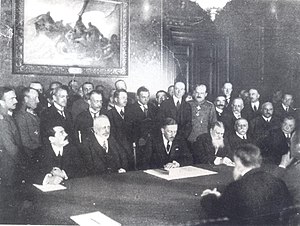
Treaty of Bucharest (1918)
The Treaty of Bucharest (1918) was a peace treaty between Romania and the opposing Central Powers following the stalemate reached after the campaign of 1917. This left Romania isolated after Russia's unilateral exit from World War I (see the Armistice of Focșani and Treaty of Brest-Litovsk).
For other treaties signed in Bucharest, see Treaty of Bucharest (disambiguation).Signed
7 May 1918
Cotroceni Palace, Bucharest, Kingdom of Romania (under Central Powers' occupation since December 1916)
Ratification by Romania and the Central Powers
 Richard von Kühlmann
Richard von Kühlmann Paul von Koerner
Paul von Koerner Johannes Kriege
Johannes Kriege Generalmajor Emil Hell
Generalmajor Emil Hell Kapitän zur See Hans Bene
Kapitän zur See Hans Bene Stephan Burián von Rajecz
Stephan Burián von Rajecz Vasil Radoslavov
Vasil Radoslavov Dimitar Tonchev
Dimitar Tonchev Major General Zanttloff
Major General Zanttloff Lyubomir Miletich
Lyubomir Miletich Ahmed Nessimy Bey
Ahmed Nessimy Bey Ahmed Izzet Pasha
Ahmed Izzet Pasha Hikmet Bey
Hikmet Bey Alexandru Marghiloman
Alexandru Marghiloman Constantin C. Arion
Constantin C. Arion I. Papiniu
I. Papiniu M. Burghele[1][2]
M. Burghele[1][2]
Following the Central Powers' ultimatum issued during the meeting between Ferdinand I of Romania and Ottokar Czernin, the Austro-Hungarian Foreign Minister, on 27 February [O.S. 14 February] 1918 at the Răcăciuni railway station, King Ferdinand summoned a Crown Council on 2 March [O.S. 17 February] in Iași, the Romanian capital-in-exile. After long and difficult discussions, which lasted 3 days, and despite the strong opposition of Queen Marie and General Constantin Prezan, the Crown Council decided to accept the ultimatum and send envoys to Buftea to negotiate a preliminary peace treaty. The preliminary peace treaty was concluded on 5 March [O.S. 20 February] 1918, by which Romania accepted frontier rectifications in favor of Austria-Hungary, to cede the whole of Dobruja, to demobilize at least 8 divisions, to evacuate the Austro-Hungarian territory still in its possession and to allow the transport of Central Powers' troops through Western Moldavia and Bessarabia towards Odessa.[4]
Alexandru Marghiloman, then Prime Minister of Romania, signed the final treaty at the Cotroceni Palace, Bucharest, on 7 May [O.S. 25 April] 1918 and it was ratified by the Chamber of Deputies on 28 June and by the Senate on 4 July 1918.[5] However, King Ferdinand refused to sign or promulgate it.
Aftermath[edit]
The treaty put Romania in a unique situation compared to other German-occupied countries. It completely respected Romania's de jure independence, and Romania ended up with more territory after the union with Bessarabia, through the requirement that German civil servants with the power of veto power be stationed in Bucharest together with the German occupation to continue until a date "later be determined", effectively turned Romania into a de facto German protectorate.[20]
Germany was able to repair the oil fields around Ploiești and by the end of the war had pumped a million tons of oil. They also requisitioned two million tons of grain from Romanian farmers. These materials were vital in keeping Germany in the war to the end of 1918.[21]
Although Bulgaria received a part of Northern Dobruja, the fact that it could not annex the whole province had a strong effect on the Bulgarian public opinion.[22] Bulgarian Prime Minister Vasil Radoslavov was forced to resign on 20 June 1918 after the failure to acquire the whole Dobruja.[22] Nevertheless, Bulgaria continued to lobby Germany and Austria-Hungary for the annexation of the whole province, including the condominium established by the Treaty of Bucharest. Representatives of Bulgarian Dobrujans held a second general assembly in Babadag on 23 September, adopting a final resolution requesting Dobruja's incorporation into Bulgaria.[22] After negotiations, a protocol regarding the transfer of the jointly administered zone in Northern Dobruja to Bulgaria was signed in Berlin on 24 September 1918, by Germany, Austria-Hungary, the Ottoman Empire and Bulgaria. In return, Bulgaria agreed to cede the left bank of the Maritsa river to Turkey.[22] The protocol was deemed a desperate attempt by the Central Powers to keep Bulgaria on their side[22] during the Vardar Offensive on the Macedonian front. In the end, the agreement was short-lived: five days later, on 29 September, Bulgaria capitulated in the face of the advancing Allied forces (see also the Armistice of Salonica).
The treaty was denounced in October 1918 by the Marghiloman government. Romania re-entered the war on 10 November 1918, the day before it ended in Western Europe, and the 1918 Treaty of Bucharest was nullified by the Armistice of 11 November 1918.[23] In 1919, Germany was forced in the Treaty of Versailles to renounce all the benefits provided by the 1918 Treaty of Bucharest.[24] The territorial transfers to Austria-Hungary and Bulgaria were annulled by the Treaty of Saint-Germain-en-Laye (1919), and the Treaty of Neuilly-sur-Seine (1919), respectively; and the Treaty of Trianon (1920) settled Romania's border with Hungary.


![The Bulgaria–Romania border in Dobruja according to the Treaty (source: US Department of State, 1918)[1]](http://upload.wikimedia.org/wikipedia/commons/thumb/d/dd/Territory_taken_from_Roumania_by_Bulgaria_according_to_the_Peace_of_Bucharest_%281918%29.png/290px-Territory_taken_from_Roumania_by_Bulgaria_according_to_the_Peace_of_Bucharest_%281918%29.png)





